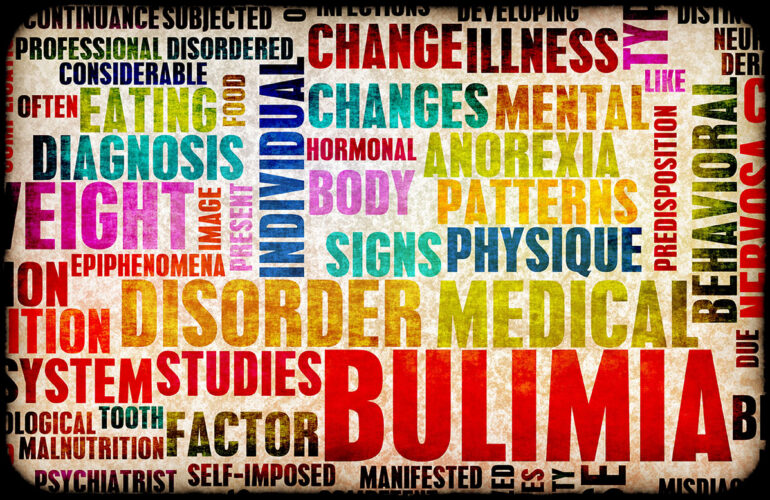Some of the most common and complicated psychiatric illnesses to treat are eating disorders. Roughly twenty million women and ten million men in the United States will experience an eating disorder at some time during their lives. These disorders don’t just affect young and middle-aged people – they are also common among older adults and seniors. While there are treatments including psychological therapy and the use of certain prescription drugs, impressive results from studies all over the world indicate that CBD may be effective in treating these difficult disorders.
Defining Eating Disorders
According to the Diagnostic and Statistical Manual of Mental Disorders 5th Edition (DSM 5) published by the American Psychiatric Association, eating disorders are “characterized by a persistent disturbance of eating or non-eating behavior that results in the altered consumption or absorption of food that significantly impairs physical health or psychological functioning”. The American Psychiatric Association finds that eating disorders and substance use disorders have common features including craving and compulsive use patterns.
Common Eating Disorders Among Younger and Middle-Aged People
Three eating disorders – binge-eating disorder, bulimia nervosa and anorexia nervosa are the most common eating disorders in the United States. Binge-eating disorder is associated with symptoms like:
- eating until you feel uncomfortably full
- eating large volumes of food when you’re not hungry
- eating faster than normal
- eating alone due to shame or embarrassment regarding the amount of food being consumed, and feeling disgusted, depressed or guilty for overeating
Bulimia nervosa is an eating disorder characterized by a cyclical pattern of binge eating and then purging to avoid gaining weight. Purging includes self-induced vomiting, the use of laxatives or diuretics, excessive exercise, and fasting.
Anorexia nervosa, on the other hand, is expressed as the loss of appetite altogether along with obsessive fears of becoming overweight or obese. It is a very difficult disorder to treat because it’s much more than just about food. It involves:
- body-image disturbance
- significant and sometimes dangerous weight loss
- refusal to maintain a normal, healthy weight
- excessive exercise
- the absence of monthly periods in females
Common Eating Disorders Among Older Adults and Seniors
Most people don’t associate eating disorders with older adults or seniors, but this isn’t the case. Eating disorders among older adults and seniors may go unnoticed because early warning signs may be missed by family, friends and even health care providers. Some common warning signs include the following:
- increased sensitivity to hot or cold foods and fluids
- behavioral changes like going to the bathroom right after eating
- dental problems
- gastrointestinal issues
- the desire to eat alone
Eating disorders that commonly affect older adults are anorexia nervosa and bulimia nervosa. In fact, late-onset eating disorders may be more common than early-onset eating disorders. Older adults may refuse meals saying that they aren’t hungry, they are too full, or feel sick. Some might purge, overuse laxatives, have distorted body image, and engage in secretive eating.
Geriatric Failure to Thrive, Alzheimer’s-Related Cachexia and Geriatric Anorexia Nervosa
Three specific age-related eating disorders include geriatric failure to thrive, Alzheimer’s-related cachexia, and geriatric anorexia nervosa. Geriatric failure to thrive in a condition marked by a multifactorial decline that may be caused by chronic co-occurring illnesses and functional impairments. Alzheimer’s-related cachexia is a condition characterized by unexplained weight loss and wasting syndrome among people diagnosed with Alzheimer’s disease. And, geriatric anorexia nervosa is the most common eating disorder among adults over age 50 and the morbidity and mortality rates are significant.
Research on CBD and Eating Disorders
It may be difficult to believe, but as far back as 1991, researchers were looking into the effectiveness of cannabinoids in alleviating symptoms of cancer-induced cachexia or the physical wasting, weight loss, and malnutrition associated with certain diseases, like cancer.
Early research also discovered that the endocannabinoid system and in particular endocannabinoid receptors have a strong effect on the regulation of eating. CB1 receptors are now known to stimulate appetite and ingestion. The endocannabinoid system also plays a significant role in energy metabolism and fuel storage in the body.
Synthetic forms of cannabinoids have been used for decades to treat anorexia and weight loss associated with AIDS, and wasting syndrome in Alzheimer’s disease and cancer. These drugs also seemed to improve pain, anxiety, depression, nausea, night sweats and insomnia.
Later research reported that defects in endocannabinoid signaling may be responsible in part, for eating disorders like binge eating, anorexia nervosa, and bulimia nervosa. It appears that this system may be located in all of the key points involved in food intake, energy expenditure and feeding behavior. A dysregulation in the system may be behind many psychiatric conditions including eating disorders.
CBD can be thought of as the key that unlocks the endocannabinoid system’s ability to do its work and regulate multiple systems throughout the body and brain. Without it, this system may remain in a state of disarray. With the help of CBD, the endocannabinoid system can help regulate eating behaviors, food intake, obesity, and energy homeostasis.
Final Thoughts on CBD and Eating Disorders
Researchers around the world are interested in the impact of CBD on many psychiatric conditions including one of the most common – eating disorders. Being one of the challenging to treat, it is hoped throughout research and medical communities that CBD will unlock the endocannabinoid system’s ability to better regulate eating and reduce risk of developing these disorders.

